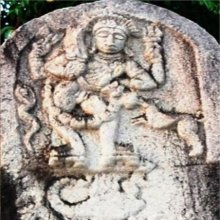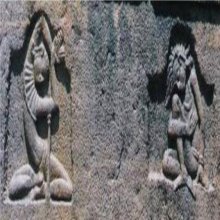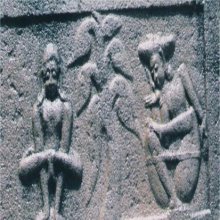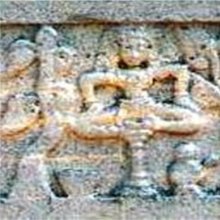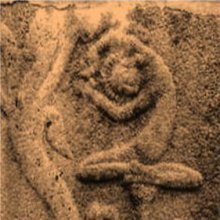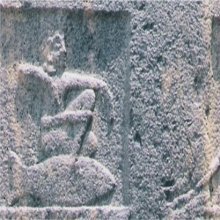Shrisailam, Śrisailam, Śrīśailam: 2 definitions
Introduction:
Shrisailam means something in Hinduism, Sanskrit, the history of ancient India. If you want to know the exact meaning, history, etymology or English translation of this term then check out the descriptions on this page. Add your comment or reference to a book if you want to contribute to this summary article.
Images (photo gallery)
(+6 more images available)
In Hinduism
Shaivism (Shaiva philosophy)
Source: DSpace at Pondicherry: Siddha Cult in Tamilnadu (shaivism)Śrīsailam has been an important Siddha-Kṣetra which was famous as the seat of the Atimārgika sects such as Pāśupatās, Kāpālikas, Kālamukhas, Navanāthās and Śāktas.
Śrisailam Inscriptions, Āndhra Pradesh.—The Siddha cult is the most important one at Śrisailam, which in all likelihood might have coterminous to the Pāśupata School. The epithet ‘Siddha Kśetra’ given to Śrisailam was due to the popularity of this cult in Śrisailam.
There are a few inscriptions found at Śrisailam which are purely related to the Siddha cult in that region. Foremost among them, a small label inscription in early 6th century characters was noticed on the rocky floor on the way to the Saraṅgadhāra matha. It reads “Sarasa Paramātmā”. The word Paramātmā means a man possessing divine or yogic powers. The prefixing word ‘sarasa’ suggests his field of excellence;that is the art of Rasa-vidyā (alchemy).

Shaiva (शैव, śaiva) or Shaivism (śaivism) represents a tradition of Hinduism worshiping Shiva as the supreme being. Closely related to Shaktism, Shaiva literature includes a range of scriptures, including Tantras, while the root of this tradition may be traced back to the ancient Vedas.
India history and geography
Source: DSpace at Pondicherry: Siddha Cult in Tamilnadu (historical)Śrisailam has important association with the traditions common to Śaivite and Buddhist tantra. On the Buddhist side, Śrisailam appears to be the Śriparvata mentioned in many Tibetan texts, where the Siddha Nāgārjuna did alchemical experiments.
Source: Shodhganga: Siddha Cult in TamilnaduShrisailam refers to one of the various famous Siddha Centre distributed throughout South India and Tamil Nadu. The Siddha cult represents a Tantric philosophy that emerged from the combination of several elements found in traditions such as Shaivism (viz., Pashupata), Shaktism, Jainism, Tantric Buddhism (Vajrayana), etc. Both the Siddha and the Navanath cult (i.e., Nava-natha, ‘nine saints’) are popular in South India [viz., Shrisailam] and Tamilnadu. A Siddha was an inspired seer belonging to the marginalized sections of society who dissolved their past karma and crushed the roots of future karma.

The history of India traces the identification of countries, villages, towns and other regions of India, as well as mythology, zoology, royal dynasties, rulers, tribes, local festivities and traditions and regional languages. Ancient India enjoyed religious freedom and encourages the path of Dharma, a concept common to Buddhism, Hinduism, and Jainism.
See also (Relevant definitions)
Full-text: Navanathacharitramu, Navanathacaritra, Cakra, Kalamukha, Panditaradhya-caritra, Basavapuanam, Palkuriki Somanatha, Rasayana, Kapalika, Rasayanakhanda, Durgaraja, Kukkutasana, Shriparvata.
Relevant text
Search found 6 books and stories containing Shrisailam, Śrisailam, Śrīśailam, Srisailam; (plurals include: Shrisailams, Śrisailams, Śrīśailams, Srisailams). You can also click to the full overview containing English textual excerpts. Below are direct links for the most relevant articles:
The history of Andhra country (1000 AD - 1500 AD) (by Yashoda Devi)
Part 9 - The Saluvas of Tirupati < [Chapter XVIII - The Saluvas]
Introduction (Saluva dynasty) < [Chapter XVIII - The Saluvas]
Part 1 - The Pallavas of Guntur (A.D. 1100-1300) < [Chapter XII - The Pallavas]
A Tribute to P. Raja Ramachandra Rao < [April – June, 2007]
The People of Andhra Pradesh and Their Heritage < [July – September 1973]
The Siva Linga: Conceptual, Iconographical and < [January – March, 1996]
Lakulisha-Pashupata (Philosophy and Practice) (by Geetika Kaw Kher)
Kalamukhas: The politically organized Saivite ascetics < [Chapter 2 - Spread and Transition]
Amaravati Art in the Context of Andhra Archaeology (by Sreyashi Ray chowdhuri)
Coastal and Maritime trade < [Chapter 4 - Survival of Amarāvatī in the Context of Andhra Art]
Preceptors of Advaita (by T. M. P. Mahadevan)
Hindu Pluralism (by Elaine M. Fisher)
Śaivism and Brahminical Orthodoxy < [Chapter 1 - Hindu Sectarianism: Difference in Unity]
Śrīvidyā and society in Nīlakaṇṭha Dīkṣita’s Saubhāgyacandrātapa < [Chapter 2 - The Making of the Smārta-Śaiva Community of South India]
Related products
